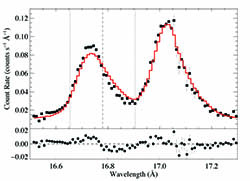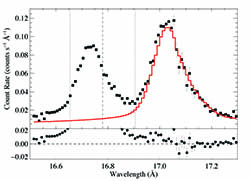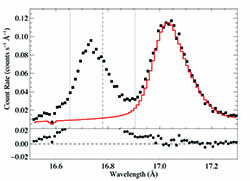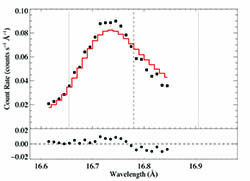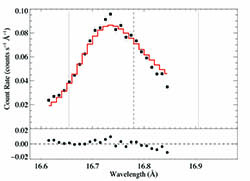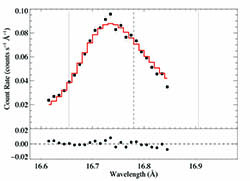ζ Pup: XMM RGS line-profile analysis
Details of the Fe XVII 16.780, 17.051, 17.096 non-porous fitting
Fitting all three lines with windprof + windprof + windprof + pow
Non-porous: RGS1+2
We show the two spectra separately, but they were fit simultaneously. That's the same model in both plots.
Note that the fit is quite poor (and even worse if we force the taustar and Ro values to be the same for each of the three model components. Also note that we fixed the normalization of the 17.10 line to be 0.7 that of the 17.05 line (as per Mauche et al.).
Here we show the same model as above, but with the normalization of the 16.78 line zeroed out, so we can see just how much blending is produced by the 17.05, 17.10 complex.
The wings of the 17.05, 17.10 complex are broad, and definitely affect the red side of the 16.78 line.
Since the 17.05, 17.10 is hopelessly blended and since we can't be sure of the exact normalization ratio, we will not include this complex in our profile analysis. instead, we'll fit just the 16.78 A line, but include model components (with parameters fixed at those derived from the fit above) for the 17 A complex, to account for the blending/contamination of the red wing of 16.78 A.
Just the 16.78 A line, but including modeled blue wing of 17 A complex
This fit is surprisingly (to me) poor, with the red wing too high, as if we're accounting for too much blending -- too big a contribution from the 17 A complex.
Let's see what kind of fit we get when we eliminate the 17 A complex model component entirely (this is the fit that I (accidentally) presented as the best-fit including blending, previously).
Just the 16.78 A line, excluding modeled blue wing of 17 A complex
This fit is much better (though still not formally good). On the other hand, it doesn't really make sense to exclude the contribution from the 17 A complex. To be safe, therefore, it seems to make sense to eliminate the entire red wing of the 16.78 A line from the fit, which will render the effect of the 17 A complex blending moot. That's what we've done on the main page.
last modified: 8 May 2012
